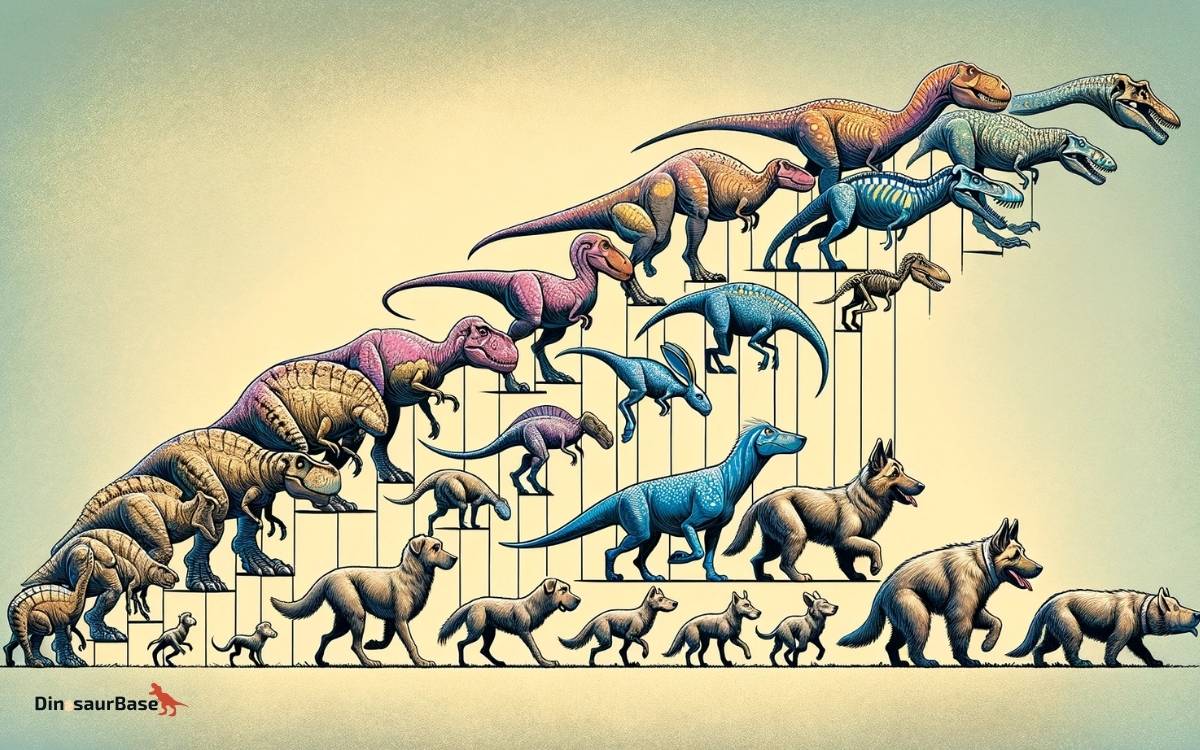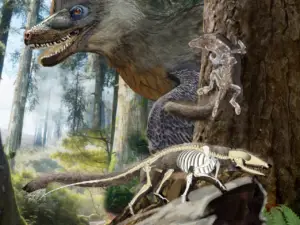How Did Dogs Evolve: Debunking the Dinosaur Myth
Dogs evolved from wolf-like ancestors, not dinosaurs. The dinosaur myth regarding canine evolution is unfounded.
Dogs, our loyal companions, share a rich evolutionary history that takes us back to their wolf ancestors roughly 15,000 to 40,000 years ago.
This period marks the domestication of wolves, which led to the diverse breeds of domestic dogs we see today.
The transformation from wild predator to beloved pet came through selective breeding and natural interactions with early humans.
These early dogs helped with hunting, offered protection, and provided companionship, leading to mutual benefits for both species.
Unlike the myth of dinosaur descent, this scientifically supported path of evolution highlights the adaptive and social nature of dogs, solidifying their place as “man’s best friend. “

The Origin Of Dogs
The story of how dogs became our beloved companions is fascinating. Dogs did not evolve from dinosaurs. Contrary to playful myths, our furry friends share a much closer ancestor.
The journey from wild wolves to playful pups is one of nature’s most remarkable transformations. Let’s delve into the evolution of dogs and uncover the facts behind their domestication.
From Wolf To Companion
Ancient wolves and modern dogs are scientifically connected. Genetic evidence shows that dogs are descendants of wolves. Thousands of years ago, some wolves started to interact with early humans.
The friendliest wolves had more chances to survive and reproduce. This natural relationship marked the beginning of a new, domesticated species—the dog.
- Human settlements offered stable food sources.
- Wolves that were less aggressive thrived near humans.
- Over time, these wolves changed physically and behaviorally.
Domestication Timeline
Dog domestication happened over many years. The timeline below outlines key transitions in this history.
| Time Period | Event in Domestication |
|---|---|
| 20,000 – 40,000 years ago | First evidence of wolves near human camps |
| 15,000 years ago | Bones of dog-like animals found with human remains |
| 9,000 years ago | Dogs widely accepted as companions across civilizations |
| 3,000 – 4,000 years ago | Appearance of breeds with specific roles (like herding or guarding) |
Today, dogs are diverse and widespread. The bond between dogs and humans is stronger than ever. Understanding their origin helps us appreciate our loyal companions even more.
Myths About Canine Evolution
Dogs have a fascinating history, but some stories about their past aren’t true. Many myths surround the evolution of our furry friends.
Let’s explore some of these tales and unfold the real story behind how dogs came to be man’s best friend.
The Dinosaur Connection
One tall tale is that dogs evolved from dinosaurs. This is not true. Dogs are mammals and dinosaurs were reptiles. These two groups have very different evolutionary paths.
The closest relatives to dogs are wolves, and they share a common ancestor that lived millions of years after dinosaurs.
Separating Fact From Fiction
- Dogs did not live with dinosaurs.
- Evolution takes a long time.
- The ancestors of dogs were not huge reptiles, but rather, small mammals.
Understanding dog evolution means looking at scientific evidence. Fossils and DNA tell us a lot. The story of dogs is a wonderful journey from wild animals to beloved pets. But, that journey never included dinosaurs.
Archaeological Evidence
Dogs have a fascinating history that goes way back in time. The tale of their evolution is one filled with intrigue and scientific discovery. By looking at archaeological evidence, we get to piece this puzzle together.
This evidence helps us understand how our four-legged friends came to be and dispels myths, such as the idea that dogs evolved from dinosaurs. Let’s delve into the details of their ancestry.
Fossil Records
Fossils are like nature’s time capsules; they hold key information about the past. Researchers and scientists have unearthed fossils that give us snapshots of ancient creatures.
These discoveries help us trace back the lineage of dogs. Remarkably, fossils have shown that dogs share a common ancestor with modern wolves.
- Fossilized bones and teeth reveal physical traits.
- Carbon dating provides accurate age estimates.
- Studies show changes over time in canine structure.
Ancient Canine Ancestors
Our journey through history reveals that dogs did not come from dinosaurs. Instead, they evolved from a group of wolves called the Canis genus.
The oldest known ancestor is the Canis lupus, which roamed the earth roughly 300,000 years ago.
| Specimen | Age (Years Ago) | Location Found |
|---|---|---|
| Canis lupus | 300,000 | Europe |
| Canis lepophagus | 10,000 | North America |
| Canis familiaris | 15,000 | Asia |
The table shows a timeline of how ancient wolves evolved. Over time, some of these wolves became domesticated and gave rise to the first dogs.
These dogs adapted to living with humans and became the loveable companions we know today.
Genetics Of Dog Evolution
The Genetics of Dog Evolution is a tale unwrapping the history of our beloved canine companions.
Through genetic studies, we’ve gained incredible insights into how dogs transformed from wild wolves to diverse breeds.
Unpicking this genetic puzzle reveals how modern dogs are not descendants of dinosaurs, but a prime example of evolution in action.
Dna Analysis Insights
DNA analysis has become the lens through which we view dog evolution. Scientists analyze genetic codes to understand the changes from ancient wolves to dogs. DNA provides a timeline, showing when certain traits emerged.
Modern Breeds And Genetic Links
The genetic tapestry of modern dog breeds is rich and varied. It links back to a few common ancestors. Genetic markers in their DNA help us connect the dots from past to present.
| Marker | Breed | Traits |
|---|---|---|
| MHC | German Shepherd | Immunity |
| SNP | Border Collie | Intelligence |
| mc1r | Golden Retriever | Coat Color |
This table shows examples of genetic markers and their associated dog breeds. Each marker influences a specific trait, such as coat color or immunity.
- Dividing breeds into groups: DNA sorts dogs into related groups.
- Mapping evolutionary paths: Genetic links clarify breed development.
- Understanding disease risks: Certain markers predict health issues.
The Impact Of Human Civilization
The journey from wild wolves to today’s diverse dog breeds is a tale intertwined with human history. Our ancestors’ influence played a pivotal role in shaping what we now know as ‘man’s best friend’.
With the dawn of civilization, humans found companions and helpers in these animals, guiding their evolution every step of the way.
Selective Breeding
Selective breeding is the process where humans breed dogs with desired traits. This practice significantly altered dogs’ appearances and behaviors over generations, aligning them more closely with human needs and preferences.
- Size varies from tiny Chihuahuas to towering Great Danes.
- Temperament adjustments have led to gentle giants and vigilant guardians.
- Physical abilities like speed in Greyhounds, show the power of selective breeding.
Dogs’ Roles In Human Societies
Dogs took on multiple roles as humans settled into agricultural lives. Loyalty and usefulness made them an integral part of society.
| Role | Examples |
|---|---|
| Hunters | Retrievers and Pointers |
| Herders | Sheepdogs and Cattle Dogs |
| Protectors | Mastiffs and German Shepherds |
| Companions | Poodles and Labrador Retrievers |
Dogs not only helped humans hunt and protect livestock but also provided companionship, which remains a cherished trait to this day.
Debunking The Dinosaur Myth
Many believe that dogs descended from dinosaurs. This notion sounds exciting but isn’t true. Our furry friends have a different story of evolution. Let’s bust this long-held myth and discover the true origins of dogs.
Why The Myth Persists
The idea that dogs evolved from dinosaurs may stem from a misunderstanding of evolution and the appeal of mixing two beloved creatures.
Popular culture often shows dogs with dinosaur toys, perhaps adding to the confusion. It’s vital to separate fun fiction from scientific fact.
Clarifying Canine Ancestry
Dogs’ ancestors were not dinosaurs. They actually come from an ancient lineage of mammals. Studies show that the closest relatives to dogs are wolves.
Dogs evolved from a group of wolves that came into contact with early human settlers.
Frequently Asked Questions For How Did Dogs Evolve: Debunking The Dinosaur Myth
Did Dogs Evolve From Dinosaurs?
Dogs did not evolve from dinosaurs. They evolved from a group of mammals known as canids, long after dinosaurs became extinct.
How Did Dogs Evolutionize?
Dogs evolved from wolves, undergoing domestication around 15,000 years ago. Selective breeding by humans has since diversified dog breeds, adapting them for various functions.
Which Ancient Creature Are Dogs Believed To Come From?
Dogs are believed to have evolved from an ancient species closely related to gray wolves.
Did Wolves Descend From Dinosaurs?
No, wolves did not descend from dinosaurs. Wolves are mammals, while dinosaurs were reptiles that lived millions of years before mammals evolved. Wolves’ ancestors were the first primitive mammals that appeared after the dinosaur extinction.
Conclusion
Dogs have journeyed far from their ancient ancestors. The dinosaur link? Simply a myth. Our canine friends are products of complex evolution, not prehistoric lizards.
We’ve explored genetics, behavior, and fossils to understand their true origins. Embracing science enriches our bond with these beloved creatures.
Their story reminds us of nature’s incredible transformations.





